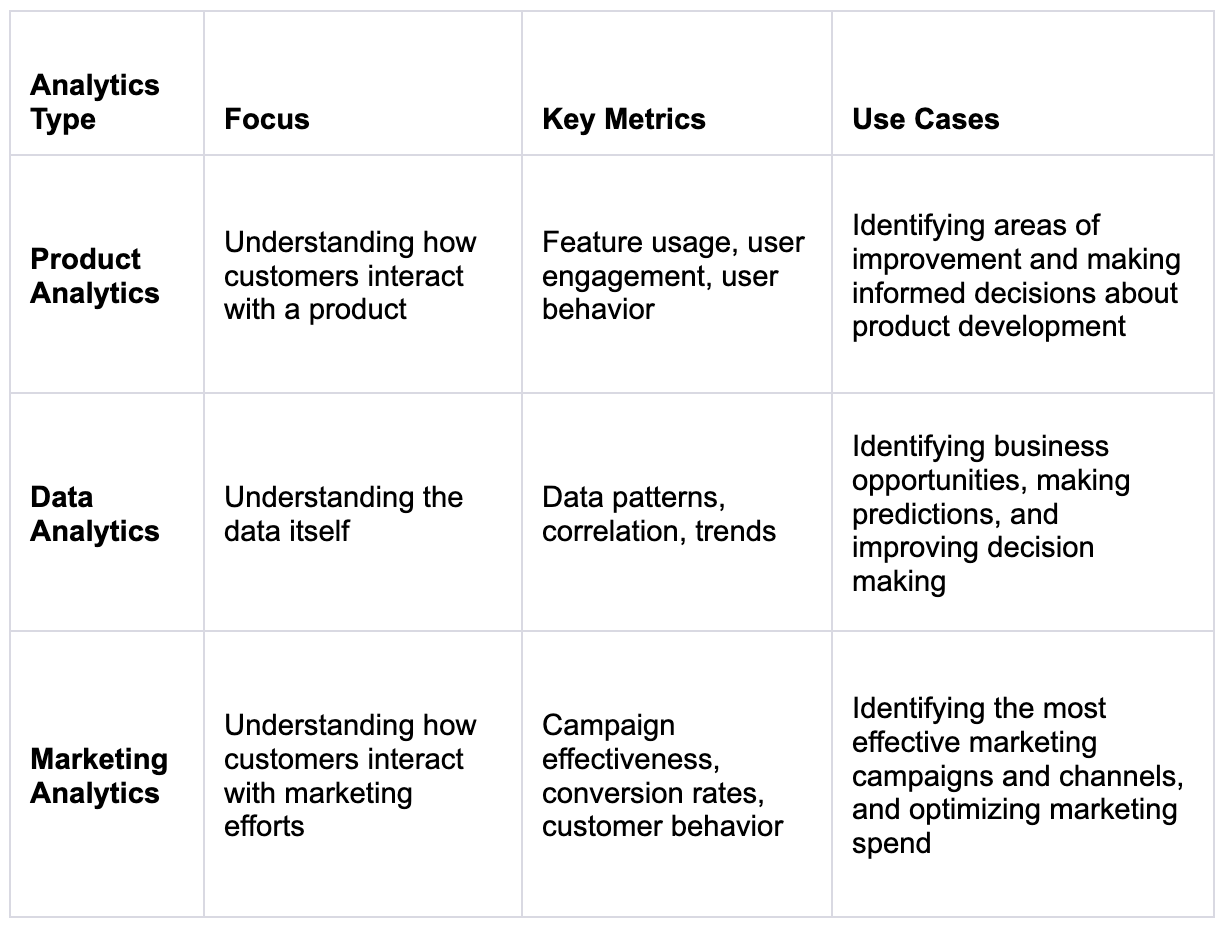In this blog post, we will take a closer look at three of the most commonly used analytics: Product analytics, Data analytics, and Marketing analytics. We'll explore the key differences between them and how each one can be used to improve your business's performance. Whether you're a product manager, data analyst, or marketer, this post will help you understand the unique value that each type of analytics can bring to your organization.
What is product analytics?
Product analytics is specifically focused on understanding how customers interact with a product, such as a mobile app or web app. It helps to identify areas for improvement and make informed decisions about your product roadmap by providing insights into user behavior and usage patterns. It is usually based on the data being collected implicitly as the users navigate through your app and make actions.What is data analytics?
Data analytics is a broader field that involves analyzing large, complex data sets to uncover insights and identify patterns to inform business decisions. It is mainly focused on understanding the data itself and can be applied to various industries, such as finance, healthcare, and retail to make strategic as well as operational decisions. Businesses may also use data analytics to connect data from different sources and create a single, holistic view of the business.What is marketing or web analytics?
Marketing analytics is focused on understanding how customers interact with a business's marketing efforts. It helps to identify which marketing campaigns are most effective and which channels are driving the most sales conversions. It also helps to track and analyze customer behavior, demographic data, and other marketing-related metrics.
It's important to note that each type of analytics can be applied in a variety of different ways, and the specific metrics and use cases may vary depending on the industry and business context. Additionally, the data collected and analyzed in each type of analytics can overlap, and often multiple types of analytics are used together to gain a complete understanding of a business's performance.
As we cleared the air on these 3 types of analytics, the very next thing that we often heard from people was,
“I’m tracking my product already with Google Analytics. So I’m sorted”.
But that’s not true. Yes, as we mentioned previously, there’s a good overlap. Before answering why, let's dive deeper into the differences between marketing analytics and product analytics.
Product Analytics
- Focuses on Engagement and Retention metrics. Sometimes, it can also be used for Acquisition, especially for PLG companies.
- Tracks granularly what a user does in the mobile app or web app even across devices.
- Can be used to track mobile, web apps and rarely, websites.
- Helps in identifying gaps and user behavior to drive product decisions for driving development efforts.
- Primarily used by product managers and early stage founders to use data-driven insights for product strategy and development.
Marketing Analytics
- Also known as web analytics, focuses on Acquisition metrics.
- Tracking is session based and so cannot go deep to provide user based insights.
- Designed to track website traffic. Though it can track mobile apps, one can not go granular in terms of reporting and insights for informing product development.
- Helps in identifying which sources or channels drive the maximum conversion for the advertising spends or even organic traffic and helps double down on those channels.
- Primarily used by marketing, sales and growth teams including growth product managers.
Why is Google Analytics not a product analytics tool?
Google Analytics is a popular web analytics tool that is widely used to track and analyze website traffic. It can provide a wide range of insights into how users interact with a website, such as which pages are most popular, where users are coming from, and how long they are staying on the site. However, it is not a product analytics tool.A product analytics tool is specifically designed to track and analyze how users interact with a product, such as a mobile app or a software application, rather than a website. It can provide in-depth insights into how users are interacting with the product, such as which features are being used most frequently, how long users are spending in the app, and where they are encountering issues.
Additionally, product analytics tools tend to be more focused on providing in-depth, granular insights that can be used to inform product development decisions. They often include features such as data visualization, data segmentation, and event tracking that are specifically tailored to the needs of product managers and other stakeholders involved in product development.
Google Analytics is not capable of tracking these kinds of insights; it doesn't have the capability to track events and user behavior inside a product or app; it can only track website interactions. While Google Analytics can provide useful insights into website traffic and user behavior, it is not designed to track usage data for products, and therefore it's not considered a product analytics tool.







